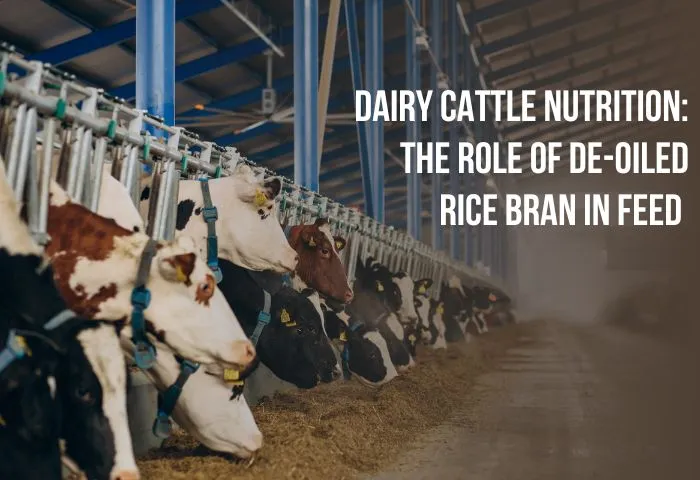As farmers and industry professionals strive to optimise dairy production, it becomes crucial to understand the various components of cattle feed and their impact on the animals’ performance.Proper nutrition plays a vital role in maintaining dairy cattle’s health, productivity, and overall well-being.
Dairy cattle require a carefully formulated diet to meet their specific nutritional requirements. A well-balanced feed provides essential nutrients such as carbohydrates, proteins, fats, vitamins, minerals, and fibre for the animal’s growth, reproduction, and milk production. Each component uniquely supports the physiological functions of dairy cattle, and any deficiency or imbalance can harm their performance.
To ensure optimal nutrition, dairy cattle feed often consists of carefully selected ingredients to provide diverse nutrients. These feed components include grains, forages, protein sources, minerals, and supplements.
In this blog, we will explain the nutritional composition of de-oiled rice bran, its potential benefits for dairy cattle, and the practical considerations for absorbing it into feed formulations. We will explore experiences to effectively utilise this feed ingredient, ultimately helping dairy farmers to make decisions about their cattle’s nutrition.
De-Oiled Rice Bran
De-oiled rice bran is a byproduct of the rice milling process. When rice is milled to produce white rice, the outer layer, known as rice bran, is removed. Traditionally, rice bran has been used as animal feed due to its nutrient-rich composition. However, technological advancements have led to the development of de-oiled rice bran, which undergoes an additional process to remove a significant portion of the oil content. This de-oiling process results in a product with improved nutritional balance and enhanced suitability for inclusion in animal feed formulations.
Benefits of De-Oiled Rice Bran in Dairy Cattle Feed
- Improved Energy Density: De-oiled rice bran offers an excellent source of energy in dairy cattle feed. With the removal of a significant portion of the oil, de-oiled rice bran provides a concentrated source of carbohydrates. This increased energy density can contribute to improved feed efficiency and support the energy requirements of lactating dairy cows, particularly during periods of high milk production.
- Enhanced Protein Quality: Protein quality is crucial for optimal milk production and overall animal health. De-oiled rice bran contains a favourable balance of essential amino acids, including lysine and methionine, essential for milk protein synthesis. Using de-oiled rice bran into the diet, dairy farmers can improve the overall protein quality and meet their cows’ specific amino acid requirements.
- High Fibre Content and Rumen Health: Fibre is essential to dairy cattle nutrition, supporting rumen health and proper digestion. De-oiled rice bran is rich in dietary fibre, including soluble and insoluble fibre. This high fibre content promotes efficient rumen function, stimulates rumination, and enhances microbial activity. Fibre in de-oiled rice bran can help maintain a healthy rumen environment, preventing digestive disorders and improving overall gut health in dairy cattle.
- Source of Essential Minerals and Vitamins: De-oiled rice bran is an energy and protein source and a valuable supplier of essential minerals and vitamins. It contains various minerals, including calcium, phosphorus, potassium, and magnesium, vital for bone development, milk production, and metabolic functions in dairy cattle.
Feeding Recommendations and Considerations
When considering the inclusion of de-oiled rice bran in the diet of dairy cattle, it is important to determine the appropriate inclusion levels based on the animal’s nutritional requirements, production goals, and overall diet composition.
Due to its favourable nutrient profile, de-oiled rice bran can serve as an excellent energy and protein source for dairy cattle. However, it is crucial to avoid over-reliance on any single feed ingredient. The inclusion level of de-oiled rice bran will depend on factors such as the energy density of the diet, the desired level of fat supplementation, and the availability of other feed ingredients.
Starting with a conservative inclusion level of de-oiled rice bran is recommended in the range of 5-10% of the total diet dry matter. Monitor the animal’s response to the diet and make adjustments based on milk production, body condition, and overall performance. Working with a qualified nutritionist can help ensure that the inclusion levels are optimised for the specific needs of the dairy herd.
Proper processing and storage of feed, including de-oiled rice bran, are crucial to maintain its nutritional quality and prevent spoilage or contamination. Consider the following recommendations for feed processing and storage:
- Grinding: De-oiled rice bran may benefit from grinding to improve its digestibility and overall diet consistency. However, grinding should be done carefully to avoid excessive heat generation, potentially damaging the feed’s nutrients.
- Mixing: Ensure thorough and uniform mixing of de-oiled rice bran with other feed ingredients to achieve a homogenous diet. This helps prevent sorting or selective feeding by the cattle, ensuring they receive a balanced nutrient intake.
- Storage: Store de-oiled rice bran in a clean, dry, and well-ventilated area to prevent moisture absorption and the growth of mould or fungi. Use appropriate storage containers or silos that protect the feed from pests and rodents. Regularly inspect the storage area to identify and address any issues promptly.
While de-oiled rice bran offers numerous benefits as a feed ingredient, its utilisation can be challenging. Here are some common challenges and ways to overcome them:
- Palatability: Some animals may initially show reduced acceptance of feed containing de-oiled rice bran due to its unique flavour or texture. To overcome this, consider gradually introducing de-oiled rice bran into the diet, allowing animals to adapt to the new feed ingredient. Mixing de-oiled rice bran with other highly palatable feed ingredients can also improve acceptance.
- Nutrient Balance: De-oiled rice bran is primarily an energy source, and its inclusion should be carefully balanced with other feed ingredients to meet the animal’s protein, vitamin, and mineral requirements. Work with a qualified nutritionist to formulate a diet that achieves the desired nutrient balance while maximising the benefits of de-oiled rice bran.
- Cost Considerations: While de-oiled rice bran can be an economical feed ingredient, its availability and cost may vary depending on geographical location. Assess the cost-effectiveness of incorporating de-oiled rice bran into the diet, considering its nutrient composition, potential benefits, and availability of alternative feed ingredients.
- Feed Quality Control: Regularly monitor the quality of de-oiled rice bran and other feed ingredients to ensure they meet the desired nutritional specifications. Conduct routine feed analysis to verify nutrient content and identify potential variations affecting animal performance.
Practical Implementation and Considerations
Practical Tips for Using De-Oiled Rice Bran in Dairy Cattle Rations are:
- Gradual Introduction: When mixing de-oiled rice bran into dairy cattle rations, it is recommended to do so gradually. Start with small amounts and gradually increase the inclusion rate for several weeks. This allows the animals’ digestive system to adjust to the new feed ingredient.
- Balanced Ration Formulation: Work with a qualified nutritionist or veterinarian to develop a balanced ration that includes de-oiled rice bran as a component. Consider the nutrient composition of other feed ingredients in the ration to ensure proper balance and avoid any nutritional imbalances.
- Quality Assurance: Ensure that the de-oiled rice bran used in the ratio is high quality. Look for a reputable supplier who follows proper processing methods to maintain nutritional integrity. Regularly check for signs of spoilage or contamination and discard any compromised batches.
- Storage and Handling: Store de-oiled rice bran in a cool, dry place to maintain quality and prevent mould growth. Please protect it from pests and rodents. Follow recommended storage practices provided by the supplier to maximise shelf life.
- Feed Management: Monitor the feed intake and performance of the dairy cattle when de-oiled rice bran is introduced. Observe any changes in milk production, body condition score, or overall health. Adjust the ratio if necessary to optimize animal performance.
Monitoring Cow Performance and Adjusting Feed Accordingly:
- Regular Performance Evaluation: Monitor the performance of the dairy cows by tracking milk production, milk composition, body weight, and body condition score. Regularly record and analyze this data to identify any changes or trends.
- Feed Intake Observation: Keep a close eye on the cows’ feed intake. Sudden decreases or increases in appetite may indicate palatability, digestibility, or overall ration balance issues. Adjust the ratio accordingly to address any observed changes.
- Body Condition Scoring: Assess the body condition score of the cows regularly. This visual assessment provides insights into the cows’ energy balance and overall health. Adjust the ratio as needed to maintain an optimal body condition score for each stage of lactation.
- Consultation with Nutritionist: Work closely with a qualified nutritionist or veterinarian to review performance data and discuss any adjustments to the ratio. They can provide expert guidance on fine-tuning the diet to optimize cow performance and meet specific production goals.
Economic Considerations and Cost-Effectiveness include:
- Cost-Benefit Analysis: Conduct a cost-benefit analysis to evaluate the economic viability of containing de-oiled rice bran into dairy cattle rations. Consider the cost per unit of nutrient provided, potential improvements in milk production, and overall feed efficiency. Compare these factors to the cost of alternative feed ingredients.
- Availability and Sourcing: Assess the availability and cost of de-oiled rice bran in your local market. Consider transportation costs, storage requirements, and any seasonal fluctuations in availability. Evaluate whether the benefits of using de-oiled rice bran outweigh the associated costs.
- Feed Efficiency and Performance: Evaluate the impact of incorporating de-oiled rice bran on feed efficiency and cow performance. Including de-oiled rice bran leads to improved milk production, enhanced feed conversion efficiency, or better reproductive performance. It can contribute to cost-effectiveness in the long run.
- Market Opportunities: Consider any potential market opportunities for de-oiled rice bran. If there is a demand for dairy products from cows fed with specific feed ingredients, including de-oiled rice bran could offer a marketing advantage and potentially increase product value.
Parting Thoughts
De-oiled rice bran offers several benefits as a potential feed ingredient for dairy cattle. Its rich energy source, protein, and fibre contribute to improved milk yield, enhanced feed efficiency, and rumen health. The favourable amino acid profile of de-oiled rice bran promotes milk production and overall animal health.
It shows promise as a valuable feed ingredient that can contribute to optimising dairy cattle nutrition. By incorporating this alternative ingredient into well-balanced feed formulations, dairy farmers have the potential to enhance milk production, improve feed efficiency, and support the overall health and performance of their cattle. With continued exploration and knowledge exchange, de-oiled rice bran has the potential to play a significant role in the future of dairy cattle nutrition.
Contact SVR Oil today to know more about their products.
FAQ’s
Q- What is DORB used for in cattle feed?
A- DORB (De-Oiled Rice Bran) is used as a supplementary feed ingredient in cattle feed to enhance energy content. It provides a good source of fat, which helps in meeting the energy requirements of the animals.
Q- What is the function of rice bran in animal feed?
A- Rice bran serves multiple functions in animal feed. It acts as a rich source of energy due to its high fat content. Its inclusion in animal diets can benefit various livestock species, including poultry, pigs, and ruminants.
Q- What is the composition of DORB ?
A- DORB (De-Oiled Rice Bran) is primarily composed of residual rice bran after oil extraction. It contains a significant amount of fat (oil), essential fatty acids, protein, fibre, and various vitamins and minerals, making it a valuable ingredient in animal feed formulations.

